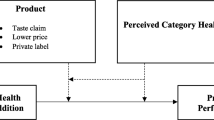Abstract
In 2016, over 6% of all retail spending at health and personal care firms was done through an electronic medium. Purchasing health products online provides an interesting challenge to consumers, as not only do consumers often have limited knowledge about which health goods that will best suit their needs (as these tend to be experience goods bought infrequently), but they also face the additional challenge of having to discern the quality of a good only based on its online listing. Hence in this context, a signal, such as the brand information of a good, may be useful in identifying its quality. Additionally, given that online purchasing decisions occur in private, we can rule out some other explanations for consumers choosing branded products, such as reputational concerns. Using data from a health goods retailer operating through Amazon.com from 2013 and 2014, we test whether brand information in the product’s listing influences the demand for health-related goods. We find that having branded information displayed in the product’s listing photo significantly increases the probability consumers consider a health good in their choice set (measured as page views) but not the demand for the goods, except for the case of bandages and dressings.
Access this chapter
Tax calculation will be finalised at checkout
Purchases are for personal use only
Similar content being viewed by others
Notes
- 1.
Sometimes consumers also can receive information on product quality online through reviews left by other consumers. However, these too can be a noisy signal, as it is unclear who the reviewers are. Especially for the case of health-related goods, it is also unclear if products that best serve one consumer may also best serve another consumer.
- 2.
We only observe a product in a given month if a positive quantity in that month was sold (except for one observation of 0 sold, which we drop). We cannot differentiate in our current data if a product was simply not offered in a given month or if it was offered but not purchased.
- 3.
This surely may introduce some selection issues (overall more demanded and perhaps higher quality products are likely to still be sold), and it is also possible that the product listings have changed over time. Yet, these issues would likely bias us against finding significant results.
- 4.
Our optimal brand variables would include information how well known the brand is, but development of such a measure is beyond the scope of this paper.
- 5.
We do not include the shipping cost in the retail price as there is evidence that consumers consider “shrouded” attributes like shipping costs the same way as they do price when making online shopping decisions. See Hossain and Morgan (2006). We also assume shipping costs faced by sellers are exactly the shipping price charged to consumers, as we only have information on the former.
References
Akerlof, G.A.: The market for ‘lemons’: quality uncertainty and the market mechanism. Q. J. Econ. 84(3), 488–500 (1970)
Bronnenberg, B.J., Dubé, J.P., Gentzkow, M., Shapiro, J.M.: Do pharmacists buy bayer? informed shoppers and the brand premium. Q. J. Econ. 130(4), 1669–1726 (2015)
Carrera, M., Villas-Boas, S.B.: Generic Aversion and Observational Learning in the Over-the-Counter Drug Market. CUDARE Working Paper (2016)
Erdem, T., Swait, J.: Brand credibility, brand consideration, and choice. J. Consum. Res. 31(1), 191–198 (2004)
Hossain, T., Morgan, J.: Plus shipping and handling: revenue (non) equivalence in field experiments on eBay. Adv. Econ. Anal. Policy 5(2) (2006)
Nelson, P.: Information and consumer behavior. J. Polit. Econ. 78(2), 311–329 (1970)
United States Census Bureau: Annual Retail Trade Survey Supplemental E-commerce Tables: 2016 (2018)
Wernerfelt, B.: Umbrella branding as a signal of new product quality: an example of signalling by posting a bond. RAND J. Econ. 19(3), 458–466 (1988)
Wolinsky, A.: Competition in markets for credence goods. J. Inst. Theoret. Econ. (JITE)/Zeitschrift für die gesamte Staatswissenschaft 151(1), 117–131 (1995)
Author information
Authors and Affiliations
Corresponding author
Editor information
Editors and Affiliations
Rights and permissions
Copyright information
© 2019 Springer Nature Switzerland AG
About this paper
Cite this paper
Trachtman, C., Van Dop, M., Villas-Boas, S. (2019). Understanding the Influence of Brand Information in Online Purchase Decisions for Health Products. In: Martínez-López, F., Gázquez-Abad, J., Roggeveen, A. (eds) Advances in National Brand and Private Label Marketing. NB&PL 2019. Springer Proceedings in Business and Economics. Springer, Cham. https://doi.org/10.1007/978-3-030-18911-2_25
Download citation
DOI: https://doi.org/10.1007/978-3-030-18911-2_25
Published:
Publisher Name: Springer, Cham
Print ISBN: 978-3-030-18910-5
Online ISBN: 978-3-030-18911-2
eBook Packages: Business and ManagementBusiness and Management (R0)




